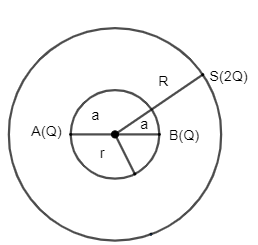
Answer
431.4k+ views
Hint: In order to find solution of this question force on A due to B must be equal to force on A due to sphere S to do so we have to find electric field on AB in order to do it we have to draw gauss’s surface inside a sphere S with radius r.
Formula used: $\oint{\overrightarrow{E}}.d\overrightarrow{A}=\dfrac{{{Q}_{in}}}{{{\varepsilon }_{0}}}$
$F=\dfrac{k{{q}_{1}}{{q}_{2}}}{{{r}^{2}}}$
Complete answer:
In order to find a solution and equilibrium condition force on A due to B is equal to force on A due to S since A and B are at equal distance and have equal charge Q.
${{F}_{AB}}={{F}_{AS}}......\left( 1 \right)$
Now force on A due to B
${{F}_{AB}}=\dfrac{1}{4\pi {{\varepsilon }_{0}}}\dfrac{{{Q}^{2}}}{{{\left( 2a \right)}^{2}}}.....\left( 2 \right)$
${{F}_{AB}}$ = electric force between A and B
k $=\dfrac{1}{4\pi {{\varepsilon }_{0}}}$= proportionality constant
Q = charge
a = radius or distance between two charges.

Force due to S and A
${{F}_{AS}}=E.Q.....\left( 3 \right)$
First we have to find electric field E we will take gauss’s surface to find electric field on A and B now,
$\oint{\overrightarrow{E}}.d\overrightarrow{A}=\dfrac{{{Q}_{in}}}{{{\varepsilon }_{0}}}$
$\overrightarrow{E}=$ Electric field
$dA$ = area
${{Q}_{in}}=$ Charge inside a sphere
${{\varepsilon }_{0}}$ = permittivity
Electric field is constant hence
$E\oint{dA=}{}_{0}\int{^{r}}\dfrac{\rho dv}{{{\varepsilon }_{0}}}$
Now we know that area of the radius r circle is
$A=4\pi {{r}^{2}}$
And it is given in question that $\rho =kr$
Now
$\begin{align}
& \Rightarrow E.4\pi {{r}^{2}}={}_{0}\int{^{r}}kr\dfrac{4\pi {{r}^{2}}}{{{\varepsilon }_{0}}}dr \\
& \Rightarrow E.4\pi {{r}^{2}}=\dfrac{4\pi k}{{{\varepsilon }_{0}}}\left( \dfrac{{{r}^{4}}}{4} \right) \\
& \therefore E=\dfrac{k{{r}^{2}}}{4{{\varepsilon }_{0}}}....\left( 4 \right) \\
\end{align}$
Now we have to find k in order to do it we will use the below equation
Charge on whole sphere
$\begin{align}
& \Rightarrow {}_{o}\int{^{2Q}}dQ={}_{o}\int{^{R}}\rho dv \\
& \Rightarrow 2Q{{=}_{o}}\int{^{R}}kr4\pi {{r}^{2}}dr \\
& \Rightarrow 2Q=k4\pi \dfrac{{{R}^{4}}}{4} \\
& \therefore k=\dfrac{2Q}{\pi {{R}^{4}}} \\
\end{align}$
Now substitute the value of k in equation (4)
$E=\dfrac{Q{{r}^{2}}}{2\pi {{\varepsilon }_{0}}{{R}^{4}}}$
From figure we can put r = a
$E=\dfrac{Q{{a}^{2}}}{2\pi {{\varepsilon }_{0}}{{R}^{4}}}...\left( 5 \right)$
Now put all the values in equation (1)
$\begin{align}
& \Rightarrow {{F}_{AB}}={{F}_{AS}} \\
& \Rightarrow \dfrac{1}{4\pi {{\varepsilon }_{0}}}\dfrac{{{Q}^{2}}}{{{\left( 2a \right)}^{2}}}=E.Q \\
\end{align}$
$\Rightarrow \dfrac{1}{4\pi {{\varepsilon }_{0}}}\dfrac{{{Q}^{2}}}{{{\left( 4a \right)}^{2}}}=\dfrac{Q.{{a}^{2}}}{2\pi {{\varepsilon }_{0}}{{R}^{4}}}\times Q$
$\begin{align}
& \Rightarrow \dfrac{1}{16{{a}^{2}}}=\dfrac{{{a}^{2}}}{2{{R}^{4}}} \\
& \Rightarrow {{a}^{4}}=\dfrac{2}{16}{{R}^{4}} \\
& \Rightarrow {{a}^{4}}=\dfrac{1}{8}{{R}^{4}} \\
& \therefore a={{8}^{-\dfrac{1}{4}}}R \\
\end{align}$
Hence the correct option is (c).
Note:
In this question we have to consider both the charge A and B inside the sphere if we consider them outside the sphere the solution could lead us to the wrong answer or solution.
Formula used: $\oint{\overrightarrow{E}}.d\overrightarrow{A}=\dfrac{{{Q}_{in}}}{{{\varepsilon }_{0}}}$
$F=\dfrac{k{{q}_{1}}{{q}_{2}}}{{{r}^{2}}}$
Complete answer:
In order to find a solution and equilibrium condition force on A due to B is equal to force on A due to S since A and B are at equal distance and have equal charge Q.
${{F}_{AB}}={{F}_{AS}}......\left( 1 \right)$
Now force on A due to B
${{F}_{AB}}=\dfrac{1}{4\pi {{\varepsilon }_{0}}}\dfrac{{{Q}^{2}}}{{{\left( 2a \right)}^{2}}}.....\left( 2 \right)$
${{F}_{AB}}$ = electric force between A and B
k $=\dfrac{1}{4\pi {{\varepsilon }_{0}}}$= proportionality constant
Q = charge
a = radius or distance between two charges.

Force due to S and A
${{F}_{AS}}=E.Q.....\left( 3 \right)$
First we have to find electric field E we will take gauss’s surface to find electric field on A and B now,
$\oint{\overrightarrow{E}}.d\overrightarrow{A}=\dfrac{{{Q}_{in}}}{{{\varepsilon }_{0}}}$
$\overrightarrow{E}=$ Electric field
$dA$ = area
${{Q}_{in}}=$ Charge inside a sphere
${{\varepsilon }_{0}}$ = permittivity
Electric field is constant hence
$E\oint{dA=}{}_{0}\int{^{r}}\dfrac{\rho dv}{{{\varepsilon }_{0}}}$
Now we know that area of the radius r circle is
$A=4\pi {{r}^{2}}$
And it is given in question that $\rho =kr$
Now
$\begin{align}
& \Rightarrow E.4\pi {{r}^{2}}={}_{0}\int{^{r}}kr\dfrac{4\pi {{r}^{2}}}{{{\varepsilon }_{0}}}dr \\
& \Rightarrow E.4\pi {{r}^{2}}=\dfrac{4\pi k}{{{\varepsilon }_{0}}}\left( \dfrac{{{r}^{4}}}{4} \right) \\
& \therefore E=\dfrac{k{{r}^{2}}}{4{{\varepsilon }_{0}}}....\left( 4 \right) \\
\end{align}$
Now we have to find k in order to do it we will use the below equation
Charge on whole sphere
$\begin{align}
& \Rightarrow {}_{o}\int{^{2Q}}dQ={}_{o}\int{^{R}}\rho dv \\
& \Rightarrow 2Q{{=}_{o}}\int{^{R}}kr4\pi {{r}^{2}}dr \\
& \Rightarrow 2Q=k4\pi \dfrac{{{R}^{4}}}{4} \\
& \therefore k=\dfrac{2Q}{\pi {{R}^{4}}} \\
\end{align}$
Now substitute the value of k in equation (4)
$E=\dfrac{Q{{r}^{2}}}{2\pi {{\varepsilon }_{0}}{{R}^{4}}}$
From figure we can put r = a
$E=\dfrac{Q{{a}^{2}}}{2\pi {{\varepsilon }_{0}}{{R}^{4}}}...\left( 5 \right)$
Now put all the values in equation (1)
$\begin{align}
& \Rightarrow {{F}_{AB}}={{F}_{AS}} \\
& \Rightarrow \dfrac{1}{4\pi {{\varepsilon }_{0}}}\dfrac{{{Q}^{2}}}{{{\left( 2a \right)}^{2}}}=E.Q \\
\end{align}$
$\Rightarrow \dfrac{1}{4\pi {{\varepsilon }_{0}}}\dfrac{{{Q}^{2}}}{{{\left( 4a \right)}^{2}}}=\dfrac{Q.{{a}^{2}}}{2\pi {{\varepsilon }_{0}}{{R}^{4}}}\times Q$
$\begin{align}
& \Rightarrow \dfrac{1}{16{{a}^{2}}}=\dfrac{{{a}^{2}}}{2{{R}^{4}}} \\
& \Rightarrow {{a}^{4}}=\dfrac{2}{16}{{R}^{4}} \\
& \Rightarrow {{a}^{4}}=\dfrac{1}{8}{{R}^{4}} \\
& \therefore a={{8}^{-\dfrac{1}{4}}}R \\
\end{align}$
Hence the correct option is (c).
Note:
In this question we have to consider both the charge A and B inside the sphere if we consider them outside the sphere the solution could lead us to the wrong answer or solution.
Recently Updated Pages
Fill in the blanks with suitable prepositions Break class 10 english CBSE

Fill in the blanks with suitable articles Tribune is class 10 english CBSE

Rearrange the following words and phrases to form a class 10 english CBSE

Select the opposite of the given word Permit aGive class 10 english CBSE

Fill in the blank with the most appropriate option class 10 english CBSE

Some places have oneline notices Which option is a class 10 english CBSE

Trending doubts
Fill the blanks with the suitable prepositions 1 The class 9 english CBSE

How do you graph the function fx 4x class 9 maths CBSE

When was Karauli Praja Mandal established 11934 21936 class 10 social science CBSE

Which are the Top 10 Largest Countries of the World?

What is the definite integral of zero a constant b class 12 maths CBSE

Why is steel more elastic than rubber class 11 physics CBSE

Distinguish between the following Ferrous and nonferrous class 9 social science CBSE

The Equation xxx + 2 is Satisfied when x is Equal to Class 10 Maths

Differentiate between homogeneous and heterogeneous class 12 chemistry CBSE




